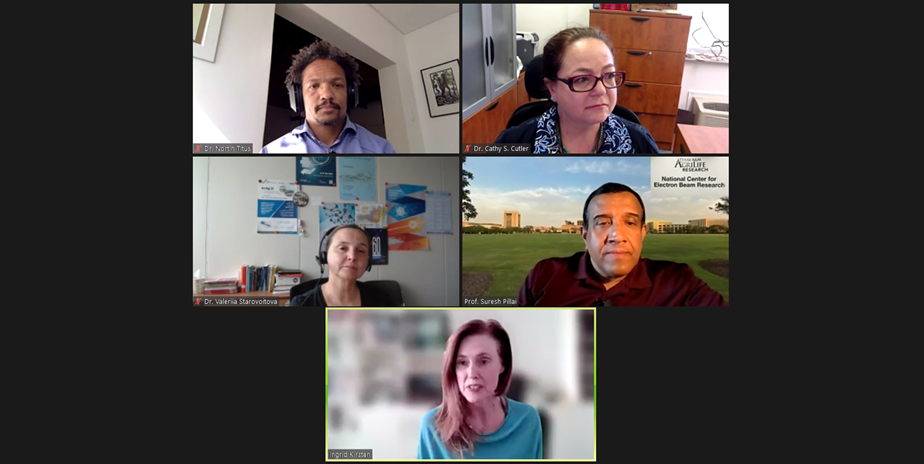
Ionising radiation from radioactive sources such as cobalt-60, cesium-137, or from electron beam (e‑beam) and X-ray machines, are used in a variety of peaceful applications of nuclear science and technology. These include the medical, health, food and agriculture, environmental and industrial sectors, and contribute to achieving the United Nations Sustainable Development Goals.
On 8 May 2023, the VCDNP hosted a hybrid panel to discuss the contribution of ionising radiation to trade and agriculture development. The discussion highlighted the opportunities and challenges in the private sector, the interface between the private and public sectors, the safety, security and sustainability considerations, and the assistance provided by the International Atomic Energy Agency (IAEA). The panel discussion was moderated by VCDNP Senior Research Associate Ingrid Kirsten.
Panellists:
Rob Elfick presented the experience of a private sector programme, X-Sterile Insect Technique (XSIT), for the suppression of the false codling moth that plagues South Africa’s citrus industry. He noted the collaborative efforts of the Citrus Growers Association of South Africa, the United States Department of Agriculture (USDA), and the IAEA in developing an integrated pest management programme in 2007. The first cobalt-60 source used by XSIT was obtained with the support of the IAEA. The XSIT programme irradiates about 50 million moths per week at 180 gray (Gy), releasing the sterile male and female moths to breed with non-sterile moths which results in unviable larvae. To be successful there has to be an uninterrupted process of breeding, irradiation and release for nine months of the year. The source of irradiation is central to the success of the project.
XSIT is currently, with the support of the United States, testing X-Ray as an alternative to gamma radiation in view of the challenges related to security, as well as the availability and cost of cobalt-60 sources. However, there are challenges with X-Ray, the most serious being moth volume throughput, scalability and the availability and reliability of the electricity supply in South Africa. Currently the sterile insect technique is a valuable element of the integrated pest management system that protects South Africa’s citrus industry and ensures that it, as the third largest citrus industry in the world, maintains its access to international markets. However, close collaboration between the private sector, government and the IAEA is required to sustain this project. XSIT has valuable intellectual property on the management of false codling moths that could be shared with other countries.
Mr. Elfick’s presentation is available here.
Shima Shayanfar focussed on the opportunities and benefits of e-beam technology for food quality, food packaging and adding value to agricultural residues and waste (for instance using cheese whey and fruit pomace to directly yield extracted, ready to eat products such as breakfast cereal, healthy snacks, protein puffs, nutrient bar). She described how the use of e-beam processing can significantly reduce the risk of infection from bacteria on food, providing an example of strawberries where the risk of E.coli infection is reduced by >99.99% after e-beam irradiation. E-beam technology is also successfully used to enhance food packaging, increase the resilience of bio-degradable packaging (through modification of the polymer material), and thereby contributes to longer shelf life for fresh food. Another application of e-beam technology is in the processing of agricultural residues or waste to convert them into beneficial products. Examples include converting sugarcane bagasse and potato peels into biogas or extracting the natural bioactive compounds from grape skins for use in food supplements, cosmetics, pharmaceutical industries or biopesticides. Consumers today expect fresh food produce to be safe, fresh, long-lasting, and affordable. Food irradiation has proven itself over many decades, with no adverse impact on food safety, quality, taste, smell or nutritional value.
Ms. Shayanfar’s presentation is available here.

Kamran Nadeem presented a case study on the establishment by private industry of an e-beam irradiation facility (PEBIL) in Pakistan. One of the drivers for the project was the need for an alternative to fumigation and chemical treatment to meet food safety standards of international export markets. From concept to operation, the project was implemented in a six-year period (from 2012 to 2018). As e-beam technology was new to Pakistan, the company faced significant challenges at the outset including a lack of regulatory standards for e-beam facilities and a lack of technical expertise in Pakistan. PEBIL chose a technology supplier that provided technical experts and continuous remote assistance. Another challenge was the reluctance of the food sector to move away from conventional practices, like fumigation, and the pharmaceutical industry to switch from gamma to e-beam technology. Switching technologies also required extensive audits and verification of the product. PEBIL conducted an intensive outreach and engagement with the public and policy makers, as well as free verification and validation trials for the pharmaceutical companies, to promote e-beam technology. The COVID-19 pandemic accelerated the acceptance and expansion of the facility to the sterilisation of medical gowns and gloves. E-beams treat 560 boxes of product per hour, which translates into cost savings for the client. An e-beam facility can also treat multiple products on the same day which results in logistical savings. As an efficient, safe, environmentally friendly technology, e-beam technology provides sustainable opportunities for the private industry in the food processing and sterilisation sector.
Mr. Nadeem’s presentation is available here.
Celina Horak provided an overview of the IAEA’s activities in radiation science and technology. Radiation technology has a multitude of applications in the medical, food, industrial, and environmental sectors and contributes to the preservation of cultural heritage. The IAEA provides ongoing support to Member States for the establishment of irradiation facilities (e-beam and gamma). These include the provision of guidelines for feasibility studies and the setting up of facilities, quality management, safety and security programmes, and the maintenance and upgrade of facilities. The IAEA also facilitates coordinated research projects (CRPs), bringing together research institutions from developed and developing Member States to collaborate on research topics of common interest. There are CRPs on the application of radiation technology in every sector mentioned above. Member States are encouraged to use this invaluable tool to improve their use and the application of the technology. Radiation technology is central to many IAEA initiatives, including Rays of Hope that focuses on cancer care, the Zoonotic Disease Integrated Action (ZODIAC), and the Nuclear Technology for Controlling Plastic Pollution (NUTEC Plastics) initiatives. NUTEC Plastics is an initiative to deal with plastic pollution through recycling using radiation technology and marine monitoring isotopic tracing techniques to precisely track and quantify the movement and impacts of microplastic particles and associated co-contaminants in the ocean.
During the discussion, panellists were asked to compare e-beam, x-ray and gamma irradiation technologies. For certain applications like the sterile insect technique, cobalt-60 remains the technology of choice given its volume throughput and scalability. The challenges posed to the use of e-beam technologies in developing countries with unreliable electricity and lack of technical expertise to operate and maintain e-beam facilities were also discussed. The point was made that using diesel generators as a back-up source of electricity adds to the overall cost of operations. On the other hand, e-beam technology has none of the security risks of cobalt-60, providing for a broader scope of application. The need for further development of X-ray and e-beam technologies in some applications such as SIT and for use in developing countries was noted. The IAEA is establishing an e-beam facility at its nuclear application laboratories at Seibersdorf to train Member States on the operation and maintenance of these machines. The panel agreed that, in many countries, more awareness raising was required to inform the public and decision makers about the benefits of food irradiation and that the food is safe for consumption. In countries such as Mexico and the United States, the experience is that people readily purchase irradiated food as it tastes and looks better than other fruits and vegetables. A further point of discussion was the importance of engagement and cooperation between the private and public sectors. The panellists and participants noted that while support from government and engagement with regulatory bodies is important when establishing radiation facilities, continued support from government and involvement of the IAEA is often essential for the long-term sustainability of facilities in developing countries.
Ms. Horak’s presentation is available here.


By continuing to use the site, you agree to the use of cookies. more information
The cookie settings on this website are set to "allow cookies" to give you the best browsing experience possible. If you continue to use this website without changing your cookie settings or you click "Accept" below then you are consenting to this.